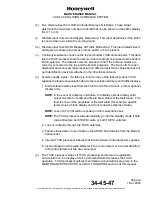
Page 49
1 Dec 2003
34-45-4
7
MAINTENANCE MANUAL
CAS-100 COLLISION AVOIDANCE SYSTEM
Use or disclosure of information on this page is subject to the restrictions in the proprietary notice of this document.
(m) The TCAS processor also controls:
1 Scheduling for interrogations done on the directional and omni antennas.
2 TCAS sensitivity level operating modes.
3 Generation of coasting data during the periods when tracking data is temporarily
not found.
NOTE:
For more details, refer to applicable Mode S Transponder manual,
recorded
in Table
Intro-1.
(n) Use of ADS-B data by the TCAS Processor will track and display other 1090 MHz
based ADS-B aircraft if the following are true:
1 The ADS-B program pin, RMP5E is strapped.
2 The Mode-S transponder(s) connected to the TCAS support the XGD protocol,
for example (0,5), (0,6), (0,8), (0,9), (1,0), (1,7), (1,8) to (1,C), (2,0), (3,0), (4,0),
(5,0), and (6,0).
3 The Mode-S transponder(s) connected to the TCAS implement, as a minimum,
BDS registers (0,5) own aircraft position, (0, 6) own surface position, and (0,9)
own velocity.
(o) When the ADS-B program pin is strapped the TPA-100A will:
1 Output on both high-speed display output busses
2 Request own aircraft position and velocity data from own transponder.
(p) The following is a brief summary about the Display Traffic Information File (DTIF):
1 The TPA-100A implements the definition of ARINC 735A supplement 1 -
Attachment 20 with one exception. In the DTIF, the range data type is encoded
with better resolution. This is currently approved by an Airlines Electronic
Engineering Committee (AEEC) subcommittee but has not been formally
adopted into a supplement of ARINC 735A.
2 The DTIF is transmitted in addition to the standard TCAS intruder display.
3 The DTIF has a consolidated list of TCAS and passive tracked aircraft.
4 The DTIF contains data that could be used by displays to give additional traffic
data to the crew.
5 When relative range, relative altitude, and relative bearing data on another
aircraft is available from TCAS surveillance and passive Automatic Dependent
Surveillance-Broadcast (ADS-B), the DTIF relative position data will be based on
TCAS surveillance.
















































